Anthony (almost 10 years old) needed new shoes, so we took him to the store and let him pick what he wanted, and this is what he got.
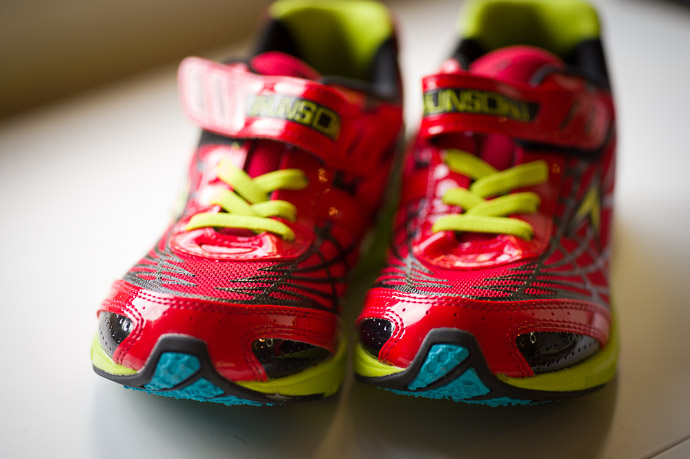
Nikon D4 + Voigtländer 125mm f/2.5 — 1/250 sec, f/2.5, ISO 1100 — image data
“Vivid”
only begins to describe these shoes
The colors are shockingly vibrant, so I thought it would be a good chance to try out the X-Rite ColorChecker Passport introduced to me in this comment a few days ago.
I still need to learn how to use it and its software to its full potential, but it's easy enough to use to profile one lighting situation...
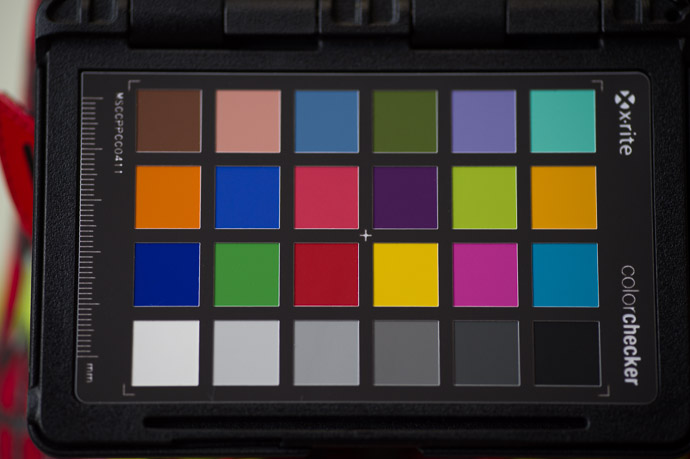
Nikon D4 + Voigtländer 125mm f/2.5 — 1/250 sec, f/2.5, ISO 500 — image data
X-Rite Color Checker Passport
via the camera-calibration profile made with this photo

Nikon D4 + Voigtländer 125mm f/2.5 — 1/250 sec, f/2.5, ISO 500 — image data
X-Rite Color Checker Passport
via the Lightroom-default “Adobe Standard” camera-calibration profile
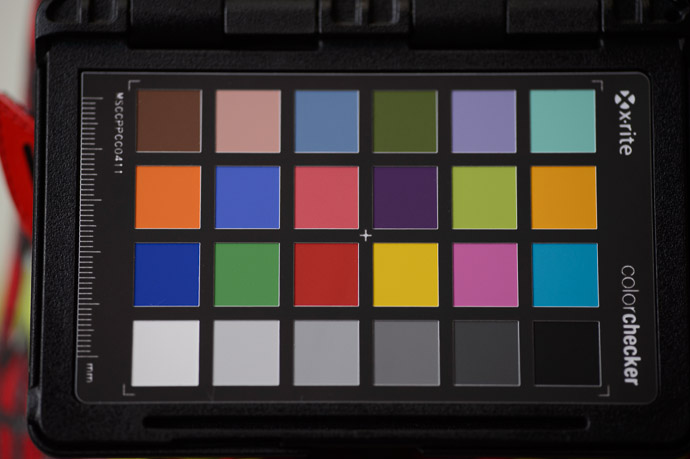
Nikon D4 + Voigtländer 125mm f/2.5 — 1/250 sec, f/2.5, ISO 500 — image data
X-Rite Color Checker Passport
via Adobe's “Camera Standard” camera-calibration profile
mouseover a button to see that image
Mousing over the buttons shows the same image processed in Lightroom using three different camera-sensor profiles; they help convert the device-dependent camera sensor color data to device-independent color data, but each with its own different interpretation.
The blues differ considerably, but every color changes.
Of course, the first question one asks is “Which is best?” or “Which is correct?”, but I don't have enough data to make a judgment yet.
I could make a judgment if I could magically view the device-independent color resulting from these profiles, comparing to the actual color squares viewed in the original light. But remember, when viewing these images on your computer, you're looking at them after they've been squeezed into the chromatically-cramped confines of the sRGB color space, compressed into the bandwidth-saving information-losing JPEG image format, filtered through a conversion to the device-dependent color data your browser thinks is needed by your display, and finally tempered by the physical limitations of your monitor (e.g. in color and brightness).
In other words, you can get some sense that there's a big difference among the interpretations, but not much else. You can't even known whether you're seeing the full extent of the differences, because some differences visible with better monitors may simply not be visible with your monitor.
I'll do tests later with the well-calibrated better-gamut Eizo monitor I have on my desktop machine, but for the moment I'll just note that there is indeed quite a difference.
mouseover a button to see that image
mouseover a button to see that image
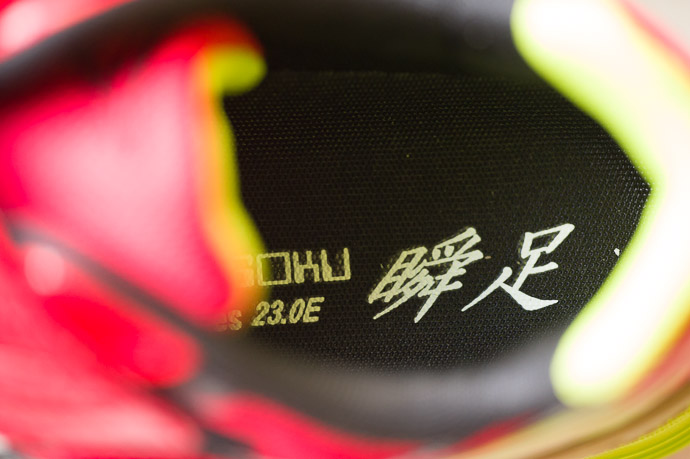
Nikon D4 + Voigtländer 125mm f/2.5 — 1/250 sec, f/2.5, ISO 5000 — image data
Shunsoku
a name that implies you can run really quickly with these shoes
( a marketing ploy that, according to the one data point I have, works 100% of the time )
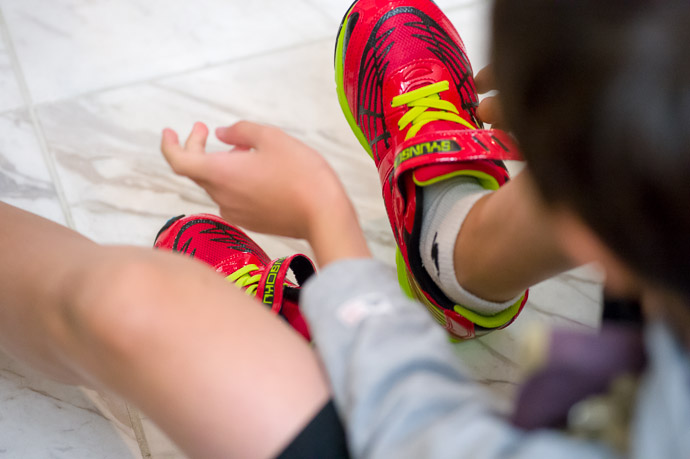
Nikon D4 + Voigtländer 125mm f/2.5 — 1/250 sec, f/2.5, ISO 9000 — image data
Off To School
this is the last time I will see these shoes even remotely close to clean
(I'm not happy with the composition of the shoe shots... they're all off angle one way or another. I had forgotten to get the shots earlier, so was quickly trying to get some before he ran off to school. He was breakfasting on Fumie's hand-made French Toast a few feet away while I was snapping them.)
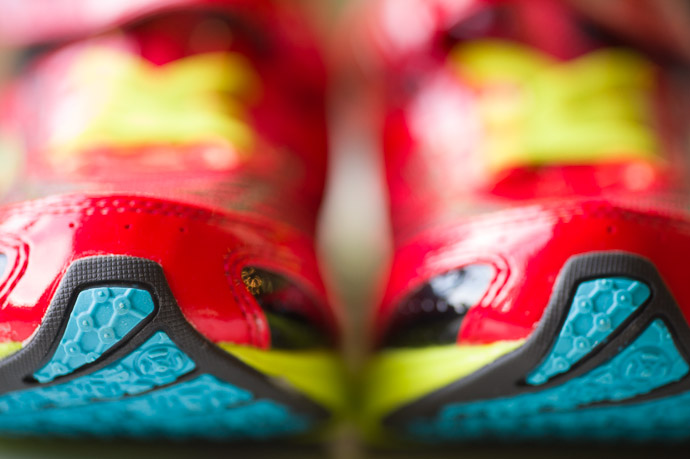
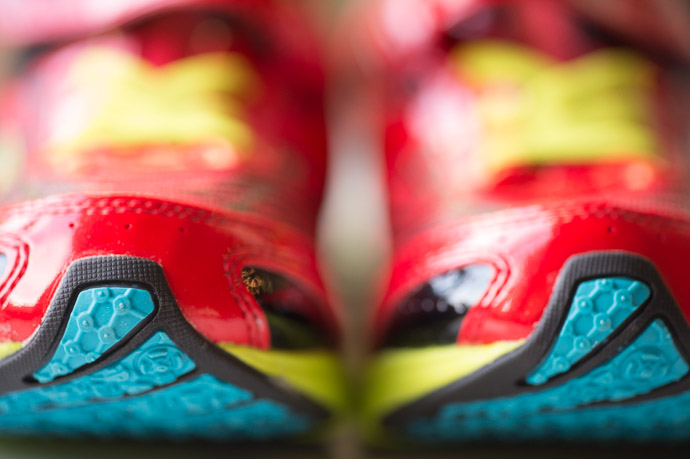
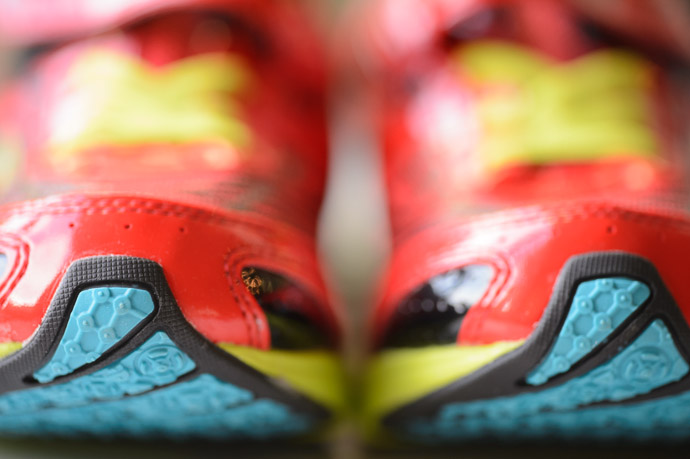
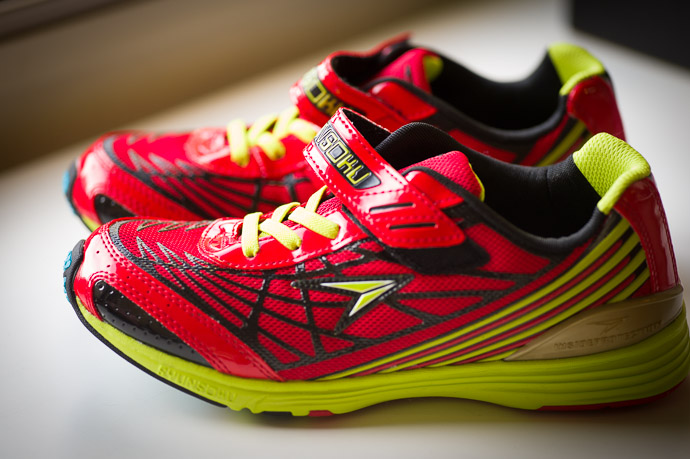
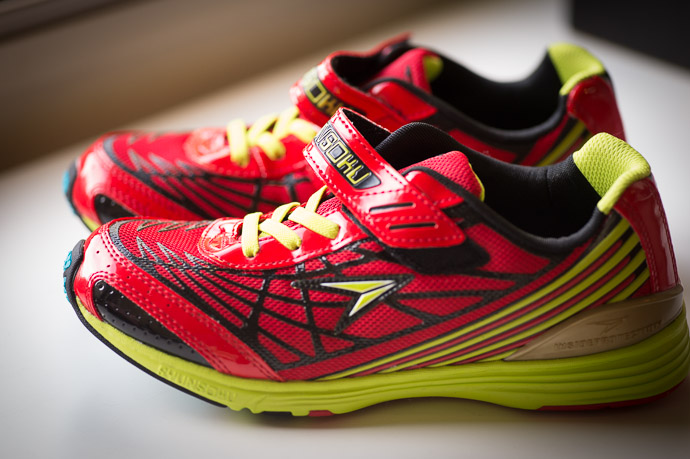
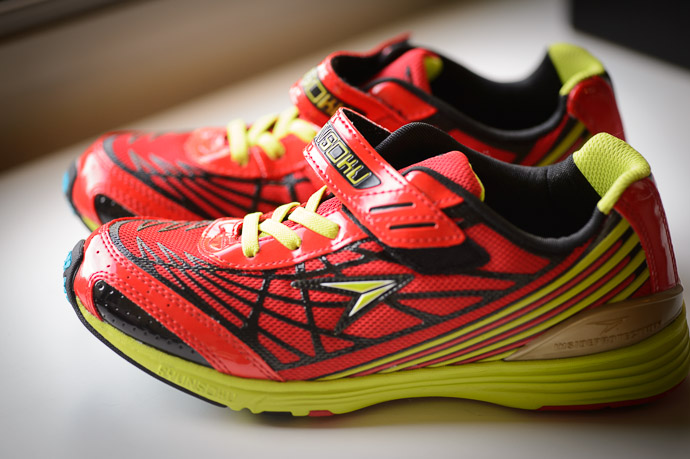
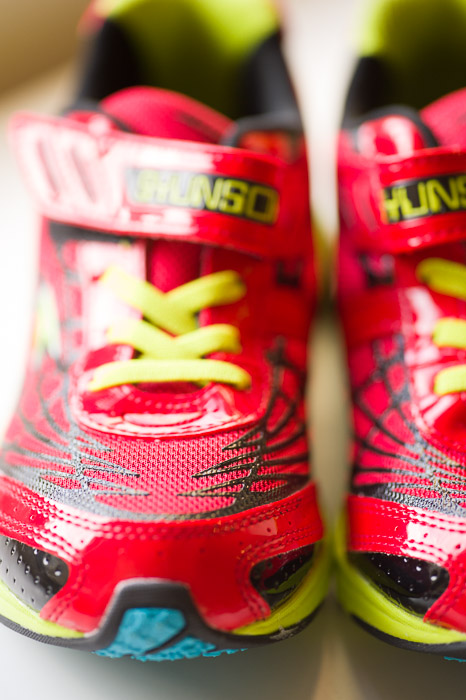
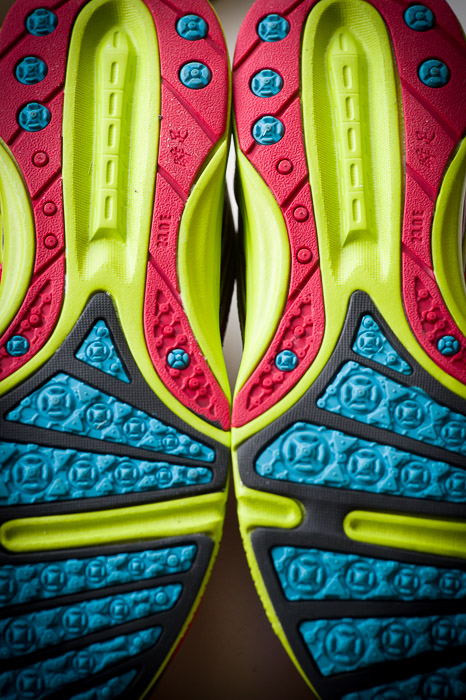
I’m surprised you hadn’t know of the X-Rite ColorChecker Passport until recently; I’ve been using one since it was first introduced and I find it to be indispensable. There are several resources available to learn more but I like Robin Myers’ review for the little details you will not find anywhere else: http://www.rmimaging.com/information/ColorChecker_Passport_Technical_Report.pdf
In addition to the profiling software that ships with the CCP, make sure to also get the DNG Profile Manager; you may need to register with X-Rite to be able to access it.
As you no doubt know by now, there are several ways to use the CCP but the most efficient way I’ve found is to simply create dual-illuminant profiles (Adobe recommends using shaded daylight and tungsten) for each of my cameras. Since you’re essentially calibrating each sensor it reduces the need to create new profiles for every shoot imported into Lightroom.
Also take a look at Adobe’s DNG Profile Editor software; the color rendering is slightly different from X-Rite’s and you might prefer that.
There’s a short explanation video for shooting a target and creating a profile with Adobe’s DNG Profile Editor software at dpBestflow.org.
Adobe’s software is more complex. But you have the option to adjust the colors and to reprocess profiles later on. Dual profiles (actually two profiles) are designed for 2850 and 6500 Kelvin. Deviating colour temperatures will be interpolated.
For my part, I prefer the CCP software. It’s simpler and automated and I don’t shoot in extreme lighting conditions so I’m satisfied with the results.
The chevron on the side reminds me of “Power” (logo is 5-sided chevron) shoes sold in India around 198[0-9] to 1993. Apparently the brand is till around: http://www.yebhi.com/91383/PD/Bata-Women-Shoes-POWER-518-5615-Red.htm
While the image now has correctly calibrated colour, that still does not mean you’re seeing it properly on the screen. Have you colour corrected the display?
Of course if you want to print stuff out and have that match everything else, then there are (ICC) colour profiles available for printers (and papers) as well. Colour correction can be one giant rabbit hole if you’re not careful. 🙂
I think you missed the paragraph that starts “I could make a judgment if I could magically view the device-independent color…” 🙂 —Jeffrey
Hi Jeffrey,
Looking forward to your posts about the ColorChecker. I have used one on and off for a few months and for my camera I notice the biggest differences in the blues. I have used it more to set the white balance then to create profiles. I have to admit I’m confused on how the DNG profile works. I am hoping you do a technical post on what exactly a DNG profile is along the lines of the posts you did on color spaces. I found those posts very informative, sometimes I think your writing just for my education:)
On another note have you ever done a post on how you do your blogs? I really like the “mouseover” views and am curious how you put that in your blog. I find that your format is great for showing photography.
I did do a quick search thru your posts and couldn’t find one but I didn’t read every one.
Here is to hoping you keep on blogging. I enjoy your posts and look forward to reading them. More than once I have been looking at your blog when someone walks in the room and comments on how great the photo I am looking at is and I have to explain it isn’t one I took. Interestingly I don’t get those comments on pictures I am looking at that I took.
ep
Oxford, Ma USA
Thanks for all the kind words. 🙂 About the “mouseover views”, I’m a geek and write them by hand (or, in this case, wrote a Perl script by hand to generate the HTML/Javascript). You can view the page source to see the results. —Jeffrey
I’m really looking forward to your future posts on the Color Checker Passport. I bought it long ago and used it intensively at the beginning. However, I quickly lost interest as I found that the profiles generated by the Xrite software showed unnatural saturated colours.
I’m quite sure I was the problem in the calibrating procedure… 😉
Once you’ve appreciated the virtues of making custom camera profiles. Don’t overlook using QP card (http://www.qpcard.com/).
This uses a different target to the X-Rite (MacBeth) ColorChecker and as a result gives subtly different results. Most people that try it find excellent with more natural colours than the profiles generated by the MacBeth Colorchecker, not a huge difference, but enough to be worth using.
Cheaper too 🙂
Paul